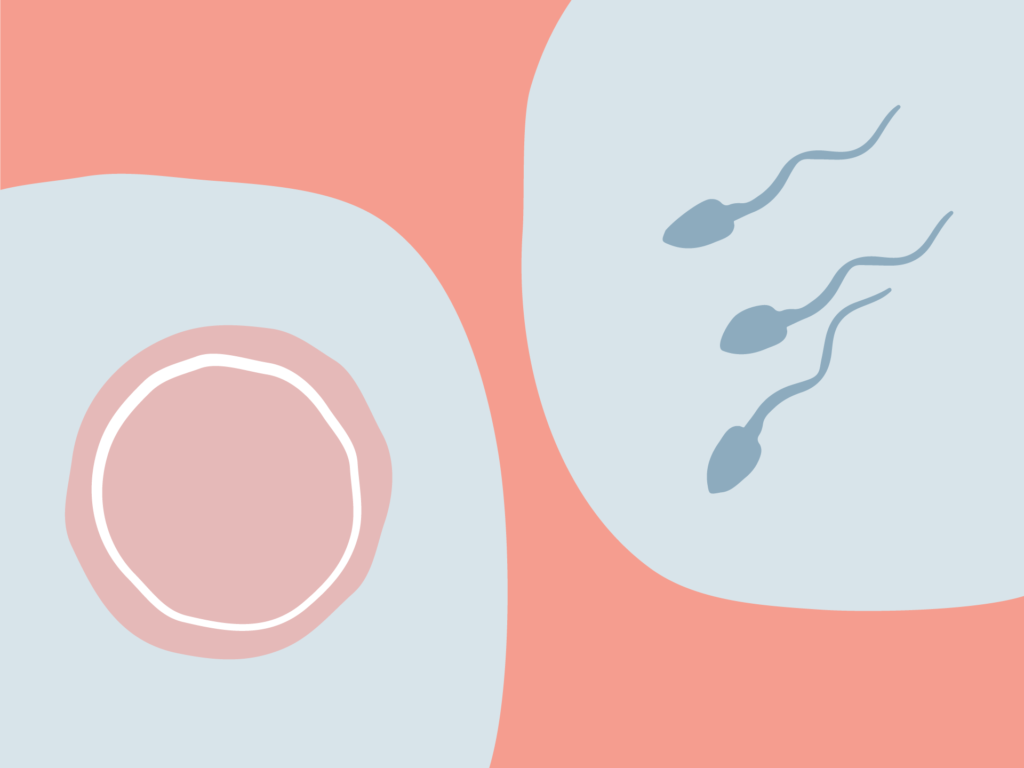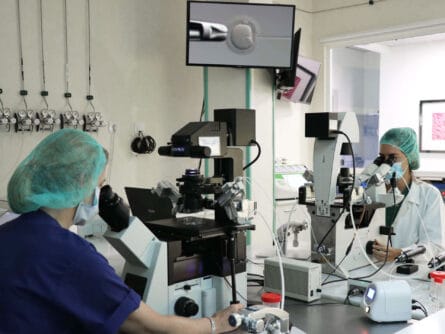What is IVF with donor eggs and sperm?
This is In Vitro Fertilisation treatment (IVF-ICSI) with donor eggs and donor sperm. The donors are anonymous and are selected for the patient based on her phenotype (physical characteristics).
Fertilisation is performed using sperm microinjection (ICSI) which is a technique in which donor spermatozoids are injected into donor eggs. The embryos that are obtained will be deposited into the gamete recipient’s uterus in order to implant and develop into a pregnancy.
Success rates with this treatment are generally quite high.

Step by step process of IVF with double donation

Egg donor selection and treatment process
All of our donors undergo a rigorous physical and mental health examination and must satisfactorily pass all the tests that are performed.
The donor’s egg retrieval is performed once the follicles have reached the ideal size, signalling maturity. In some cases, the gamete recipient will be prescribed HCG to imitate the process of natural ovulation.

Obtaining the sperm sample
The donor sperm sample will be thawed the same day the egg donor undergoes the egg retrieval procedure. In Spain, for legal reasons, the sperm sample needs to have remained frozen for at least 6 months before it can be used for treatment. The sample is processed in the laboratory so that the biologists can select the best quality spermatozoids to fertilise the donor eggs.

Fertilisation and embryo culture
Fertilisation is performed using sperm microinjection (ICSI), a technique in which the spermatozoids are injected into the eggs with the help of a microneedle.
Following this process the embryos will remain in the laboratory for a few days until it’s the best time to transfer them. Special laboratory techniques may be used in certain cases.

Treatment for the gamete recipient
The endometrium is prepared for embryo transfer with the help of oestrogens which you’ll start taking when you get your period. At least two ultrasound scans will be necessary. This stage usually lasts 12-14 days.

Pregnancy test
A blood test known as B-HCG (beta) is performed to see if the patient is pregnant about 12 days after the embryo has been transferred. Never stop taking your medication, regardless of your result, until you have first spoken with your gynaecologist and have received instructions concerning the next steps.
The first ultrasound scan will be performed to confirm the type of pregnancy (singleton or multiple), and the presence of a heartbeat about 15 days after the B-HCG analysis.
What will my treatment be like if I don’t live in Spain?
We know that when a woman decides she wants to become a mother she is making one of the most important decisions of her life. Because the desire to be a mother is one that crosses all races, languages and borders, our International Department wants to be by your side when you need it most in order to make your journey as pleasant as possible. Our International Department is made up of native coordinators who will accompany you before, during and after your pregnancy.
We’ll assign you a doctor and a native coordinator
Who will assist you in your native language from the moment you first contact us.
You’ll only need to make one trip to Spain
Which you’ll be able to arrange far enough in advance so that you can book hotels, flights and time off from work. The rest of your appointments can be carried out remotely: by video-call, phone or email.
1st visit is cost-free
If you’d like to meet us in person and undergo all of the preliminary testing with us.
Preliminary testing and ultrasounds during treatment
This can also be done in your country with your gynaecologist. We’ll send you all the necessary instructions.
We’ll adapt to you.
With the necessary resources to get started once you’re ready. No waiting times.
Success rates
At Ginemed our success rates are around 79% for double embryo transfers carried out on Day +5 (blastocyst stage), confirmed by a positive Beta HCG result. The likelihood of achieving a pregnancy doesn’t depend on the recipient’s age, but rather on the number of embryos transferred and their quality.
Cumulative success rates with egg and sperm donation treatment increase with each embryo transfer. By the third embryo transfer, 90% of patients have conceived; it’s not always necessary, however, to undergo more than one embryo transfer in order to achieve a pregnancy.
Given the age of the eggs, the chances of miscarriage or chromosome abnormalities once a pregnancy has been achieved are always lower than if the patient had conceived naturally.
Pregnancy rates by Beta HCG
1 embryo on Day +5 (Blastocyst)2 embryos on Day +5 (Blastocyst)* Ginemed Results 2019
First fertility visit is free
Request your first appointment cost-free at the clinic closest to you
Frequently asked questions about egg and sperm donation
Egg and sperm donation is recommended in the following cases:
- Absence of a male partner. Single women or same sex female couples (monoparental and homoparental families).
- Poor sperm and egg quality. Azoospermia, severe oligoasthenoteratozoospermia, very elevated sperm DNA fragmentation, recurrent miscarriage due to diminished egg quality, primary ovarian failure, menopause (true and/or premature menopause), and ovarian failure due to surgery, chemotherapy, radiotherapy or advanced maternal age.
- Previous failed cycles of In Vitro Fertilisation: poor responders, repeated ICSI failure and repeated implantation failure.
- Genetic abnormalities. In cases where either the male or female have chromosome abnormalities that cannot be screened for with the Pre-implantation Genetic Test (PGT).
No, in double donation treatment the ovaries will not be stimulated like in a cycle of IVF with own eggs. Treatment involves taking oestrogen and progesterone; the former is administered via transdermal patches or oral tablets, and the latter is administered via vaginal pessaries.
The main advantage of this type of treatment is that success rates are much higher, and the chances of miscarriage and/or chromosome abnormalities are very low given that both the egg and sperm have come from young donors.
In this case, the gamete recipient’s age is important, but not when it comes to success rates. Even patients of advanced maternal age have very good chances of conceiving with this type of treatment.
Another option would be embryo adoption. These embryos have already been created and vitrified (frozen), and they come from other couples who decided to donate them after they had already been frozen.
Embryo adoption does not offer the same success rates, and the possibility to select embryos based on the donors’ physical characteristics is much more limited.
There is no legal limit regarding the number of treatment cycles a patient can undergo. Each case will be evaluated and the medical recommendation will be personalized and based on the woman or couple’s particular situation.
